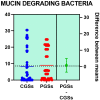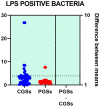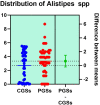Gallstone Disease and Bacterial Metabolic Performance of Gut Microbiota in Middle-Aged and Older Patients
- PMID: 35702368
- PMCID: PMC9188808
- DOI: 10.2147/IJGM.S350104
Gallstone Disease and Bacterial Metabolic Performance of Gut Microbiota in Middle-Aged and Older Patients
Abstract
Background: Gallstone disease (GSD) is more commonly presented in aged people.
Purpose: The purpose of the study was to explore the insights of metabolic performance of bacterial species from gut microbiota as well as the clinical background in middle-aged and elderly patients with GSD.
Patients and methods: This is an observational study concerning 120 research participants. Of those, 90 patients with symptomatic GSD addressed for cholecystectomy, average age 59.83 ± 15.32 years: 45 with cholesterol rich gallstones (CGSs), 45 with pigment gallstones (PGSs) and 30 healthy controls joined this observational study. Clinical examination, lab work-ups, upper and lower digestive video-endoscopies, abdominal ultrasound/CT and gallbladder motility assessment by Dodd's method were performed. Overall stool dysbiosis (DB) was assessed as 1 = minor, 2 = mild, 3 = severe, species being identified by matrix-assisted laser desorption ionization method. Stool samples from dysbiotic patients were analyzed by a next generation sequencing method with operational taxonomic unit identification.
Results: Patients with GSD presented with a significant high range of overall gut DB (p < 0.0001) when compared with controls. Those with CGSs compared with those having PGSs displayed significant clinical differences related to elderly age, lifestyle and diet particularities, obesity, dyslipidemia, nonalcoholic fatty liver disease, hypertension, type 2 diabetes mellitus or impaired glucose tolerance, as well as motility disturbances of gallbladder with a decrease of the ejection fraction. Significant increase of overall DB range and alterations of several functional bacterial species with a decrease of butyrate, lactate, acetate/propionate and methane producers, mucin degrading bacteria, biodiversity index of microbiota, as well as an increase of lipopolysaccharide positive bacteria were significantly present in patients with CGSs.
Conclusion: Middle-aged and elderly patients with GSD and a clinical background characterized by particular lifestyle, metabolic and gallbladder motility issues displayed significant modifications of biodiversity, overall gut DB and alterations of several functional bacterial species, with a decrease of their metabolic performance.
Keywords: biliary calculi; dysbiosis; intestinal functional bacteria.
© 2022 Georgescu et al.
Conflict of interest statement
The authors report no conflicts of interest in this work.
Figures




















Similar articles
-
Cholesterol Gallstones and Long-Term Use of Statins: Is Gut Microbiota Dysbiosis Bridging over Uncertainties?Diagnostics (Basel). 2024 Jun 12;14(12):1234. doi: 10.3390/diagnostics14121234. Diagnostics (Basel). 2024. PMID: 38928650 Free PMC article.
-
Dyspepsia and Gut Microbiota in Female Patients with Postcholecystectomy Syndrome.Int J Womens Health. 2022 Jan 26;14:41-56. doi: 10.2147/IJWH.S342882. eCollection 2022. Int J Womens Health. 2022. PMID: 35136356 Free PMC article.
-
Gut microbiota dysbiosis and bacterial community assembly associated with cholesterol gallstones in large-scale study.BMC Genomics. 2013 Oct 1;14:669. doi: 10.1186/1471-2164-14-669. BMC Genomics. 2013. PMID: 24083370 Free PMC article.
-
Gallstones in the Era of Metabolic Syndrome: Pathophysiology, Risk Prediction, and Management.Cureus. 2025 Mar 13;17(3):e80541. doi: 10.7759/cureus.80541. eCollection 2025 Mar. Cureus. 2025. PMID: 40225487 Free PMC article. Review.
-
Gallstone Disease and Microbiome.Microorganisms. 2020 Jun 2;8(6):835. doi: 10.3390/microorganisms8060835. Microorganisms. 2020. PMID: 32498344 Free PMC article. Review.
Cited by
-
Comparative Analysis of Antibiotic Resistance in Acute Cholangitis Patients with Stent Placement and Sphincterotomy Interventions.Life (Basel). 2023 Nov 13;13(11):2205. doi: 10.3390/life13112205. Life (Basel). 2023. PMID: 38004344 Free PMC article.
-
The gut microbiota: A new perspective for tertiary prevention of hepatobiliary and gallbladder diseases.Front Nutr. 2023 Feb 6;10:1089909. doi: 10.3389/fnut.2023.1089909. eCollection 2023. Front Nutr. 2023. PMID: 36814514 Free PMC article. Review.
-
The gut microbiome predicts response to UDCA/CDCA treatment in gallstone patients: comparison of responders and non-responders.Sci Rep. 2024 Jan 30;14(1):2534. doi: 10.1038/s41598-024-53173-2. Sci Rep. 2024. PMID: 38291113 Free PMC article.
-
The gut microbiota features and the application value in predicting recurrent risks for gallstone patients who underwent laparoscopic cholecystectomy.mSystems. 2025 Aug 19;10(8):e0176024. doi: 10.1128/msystems.01760-24. Epub 2025 Jul 25. mSystems. 2025. PMID: 40709922 Free PMC article.
-
Evaluating Weight Loss Efficacy in Obesity Treatment with Allurion's Ingestible Gastric Balloon: A Retrospective Study Utilizing the Scale App Health Tracker.Clin Pract. 2024 May 6;14(3):765-778. doi: 10.3390/clinpract14030061. Clin Pract. 2024. PMID: 38804393 Free PMC article.
References
-
- Watanabe G, Hashimoto M, Matsuda M. Evaluation of new classification of Japanese gallbladder stones (1986) with chemical componential analysis. J-Stage. 2017;31(2):205–213.
-
- Radu D, Olariu S, Marinescu A, Georgescu D, Teodorescu M. Laparoscopic cholecystectomy, rate and predictors for conversion. Surg Endosc. 2011;25:54.
LinkOut - more resources
Full Text Sources
Miscellaneous

